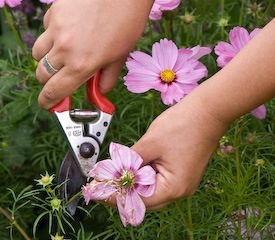
Good news — perennials aren’t especially pest-prone. If they’re growing in an appropriate spot with elbow room and you water regularly, they’re in good shape. And healthy plants are your best defense against potential problems. There are but a handful of common perennial-garden pests. Read on for their descriptions and some ways to control them:
- Aphids: These small whitish critters congregate on stems and nodes, sucking the life out of your plants. A strong spray from the hose can dislodge them. Ladybugs can also make a quick meal of aphids, so don’t get rid of these helpers.
- Black vine weevils (snout beetles): In late spring and early summer, these critters are harmless pupae resting in your soil. Then the adults emerge and eat the foliage of dozens of perennials (and lay eggs for the next generation while they’re at it). The telltale sign is notched leaf edges, especially lower down on the plant where the insects find more shelter. Starting in early fall, the newly hatched grubs eat roots. Launch your counterattack in fall by releasing beneficial nematodes (roundworms), available from well-stocked garden centers and mailorder sources; apply according to label directions. Other pesticides are registered for controlling these creatures; check with you local Cooperative Extension Service agent for more information.
- Leaf miners: These bugs form brown or tan or clear traceries — tunnels or channels — on affected leaves but rarely kill the plant. Just remove and discard affected leaves, and the plant will generate new ones.
- Root nematodes (roundworms): Affected plants develop severely distorted growth. Rip the plants out and discard them before the problem spreads.
- Voles: These little rodents slip out of their underground tunnels when you’re not looking and nibble on your perennials, especially the leaves but also roots, seeds, and bulbs. They’re a bit larger than mice, with a shorter tail and smaller ears. You can try trapping them with a baited mousetrap, but the best deterrent is a cat who’s a good hunter. Castor oil as a repellent works fairly well. You can also surround plants with small moats of sharp gravel.
As for diseases, they, too, are mercifully few on healthy perennials. You may encounter mildew or other fungal diseases. These problems appear as spots or a powdery coating on leaves, and severely affected plants may have distorted growth and buds that fail to open. If the problem is bad, tear out the plants or resort to spraying with a fungicide.
If fungal problems are chronic in your garden, your best line of defense is good air circulation, particularly in hot, humid summer weather. Also, be sure to pick off and discard sick leaves or clean up fallen affected leaves around the base of your plants. Regular, even watering right at the roots (that is, not splashing the leaves) is also wise.
Of course, an easy way to avoid both pests and diseases is not to grow vulnerable plants! You can deliberately seek out varieties touted as resistant.










